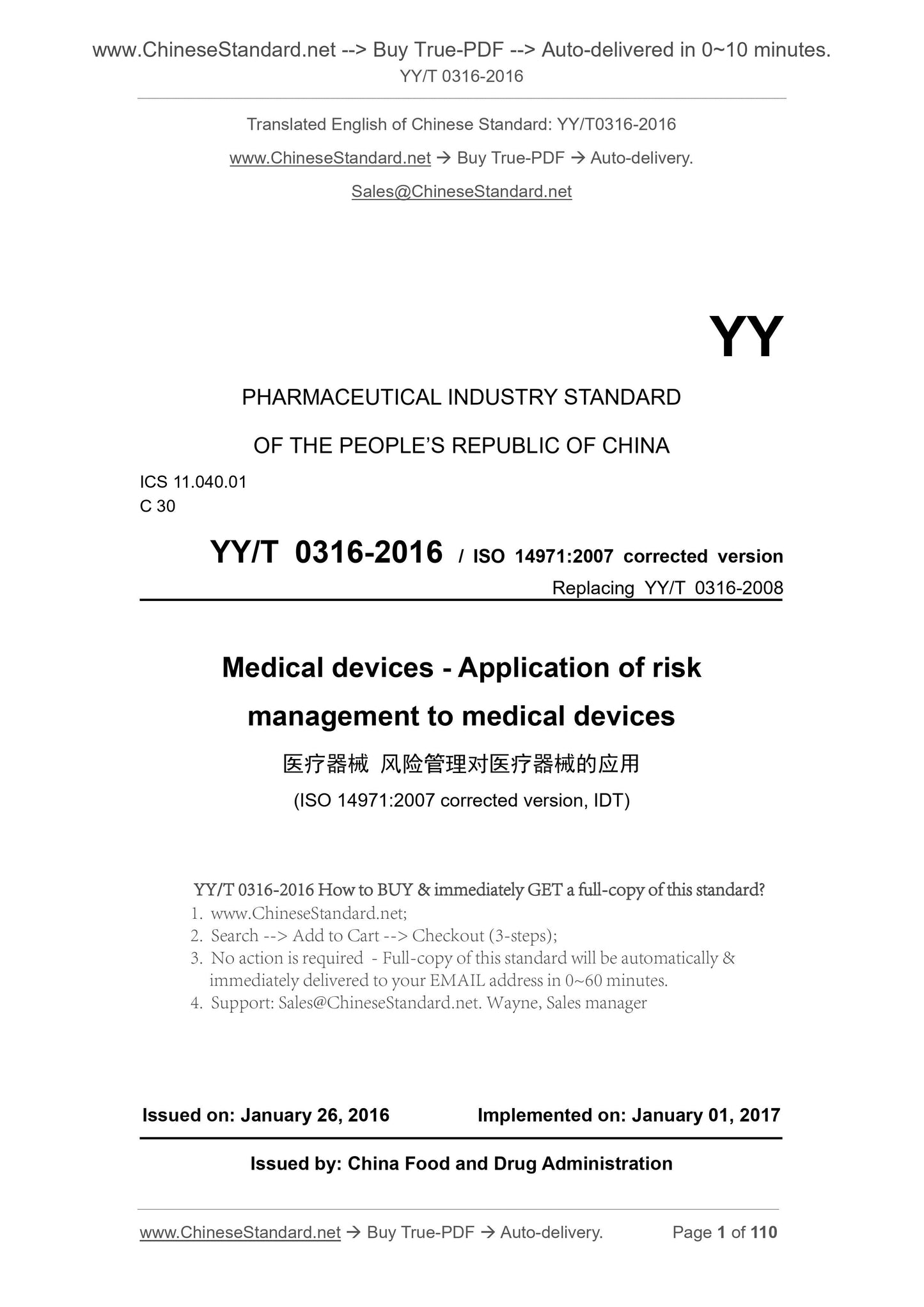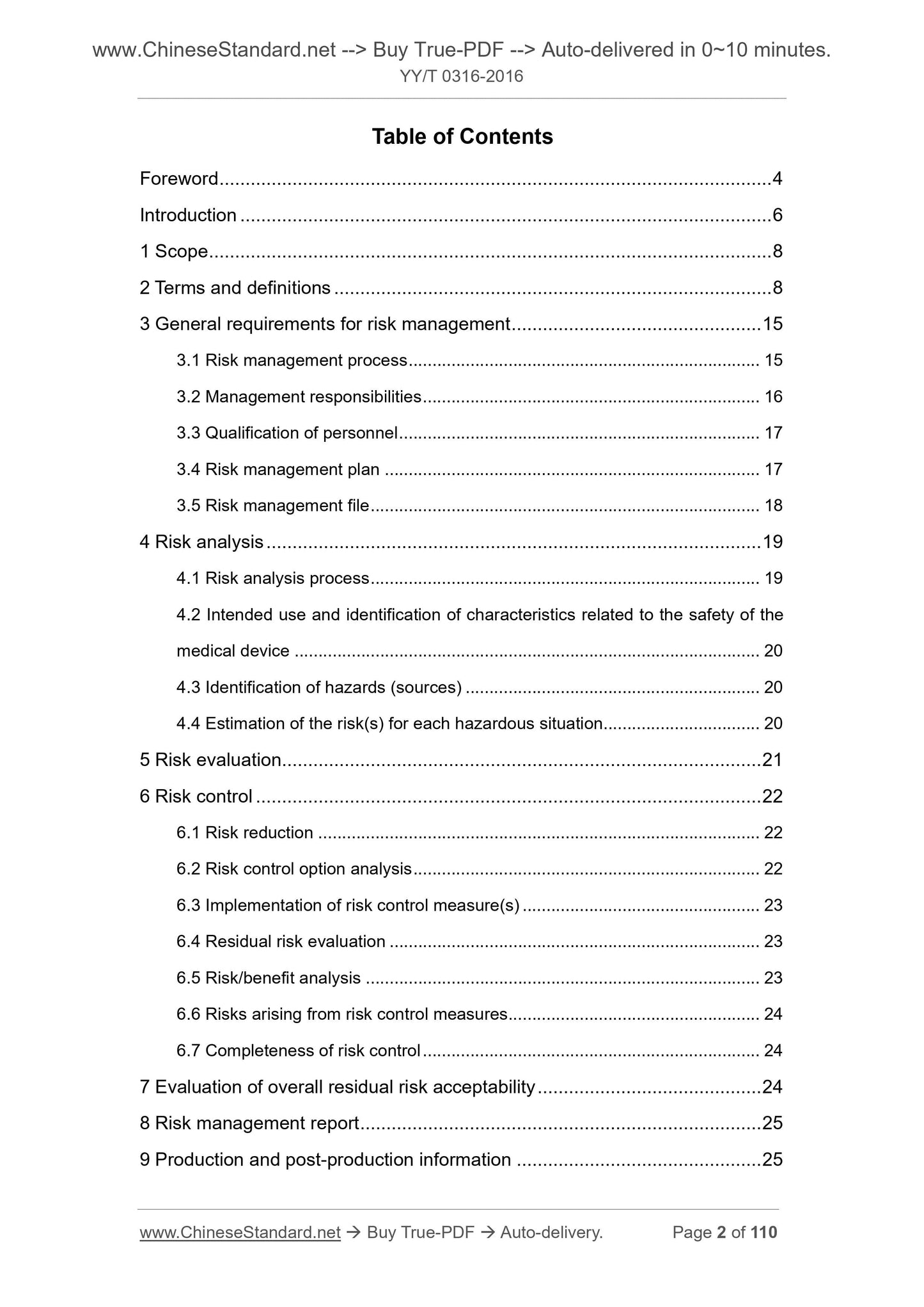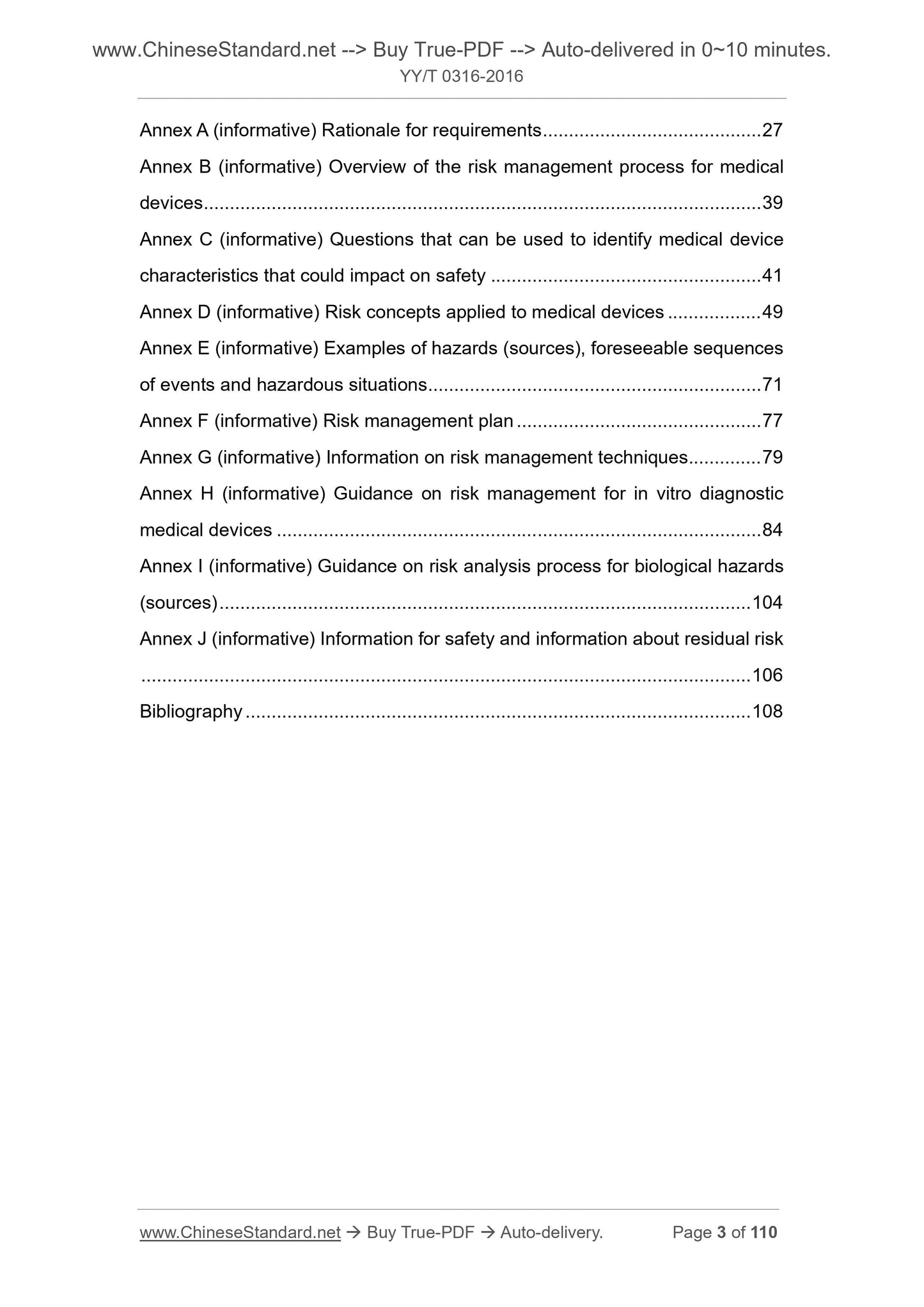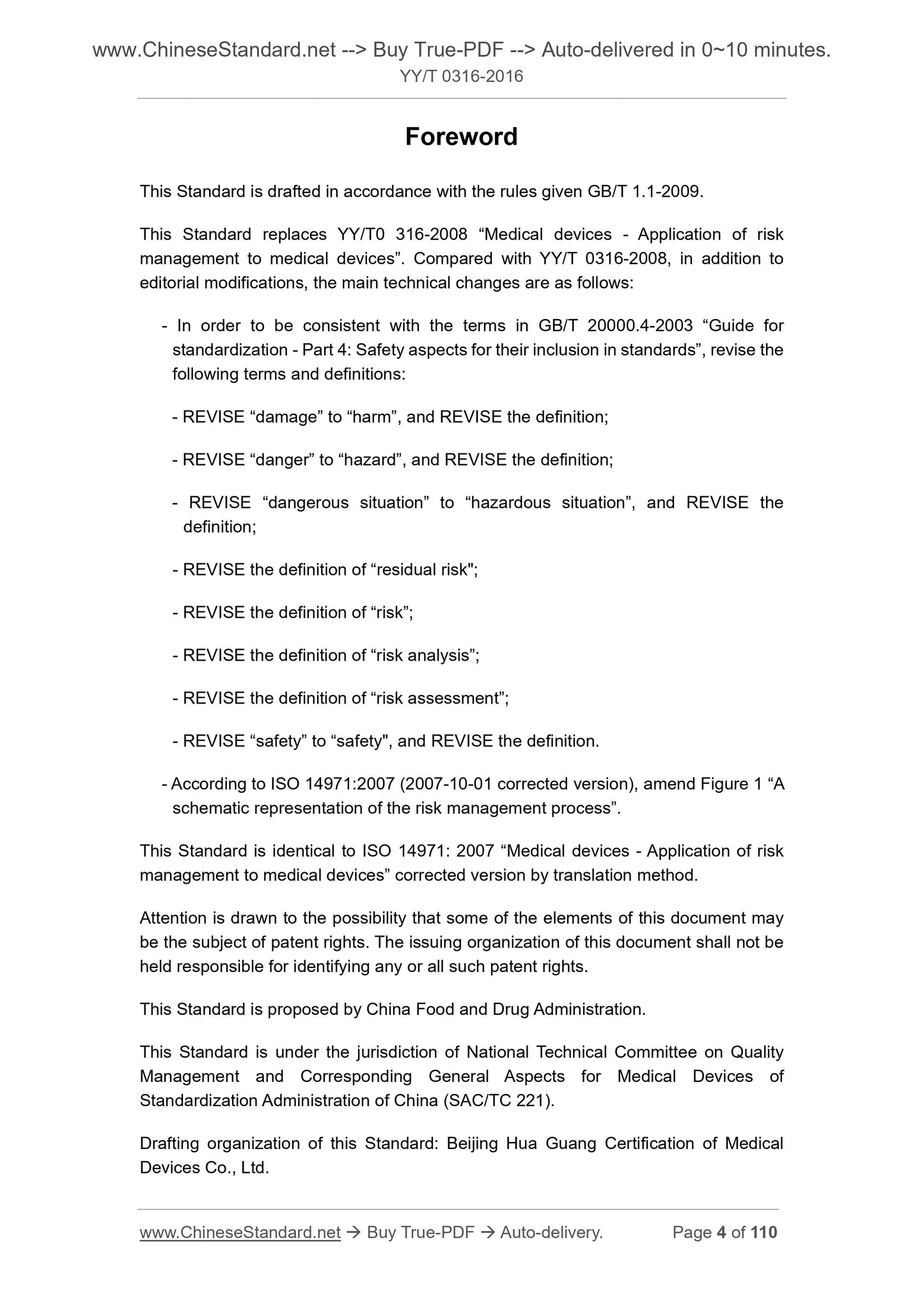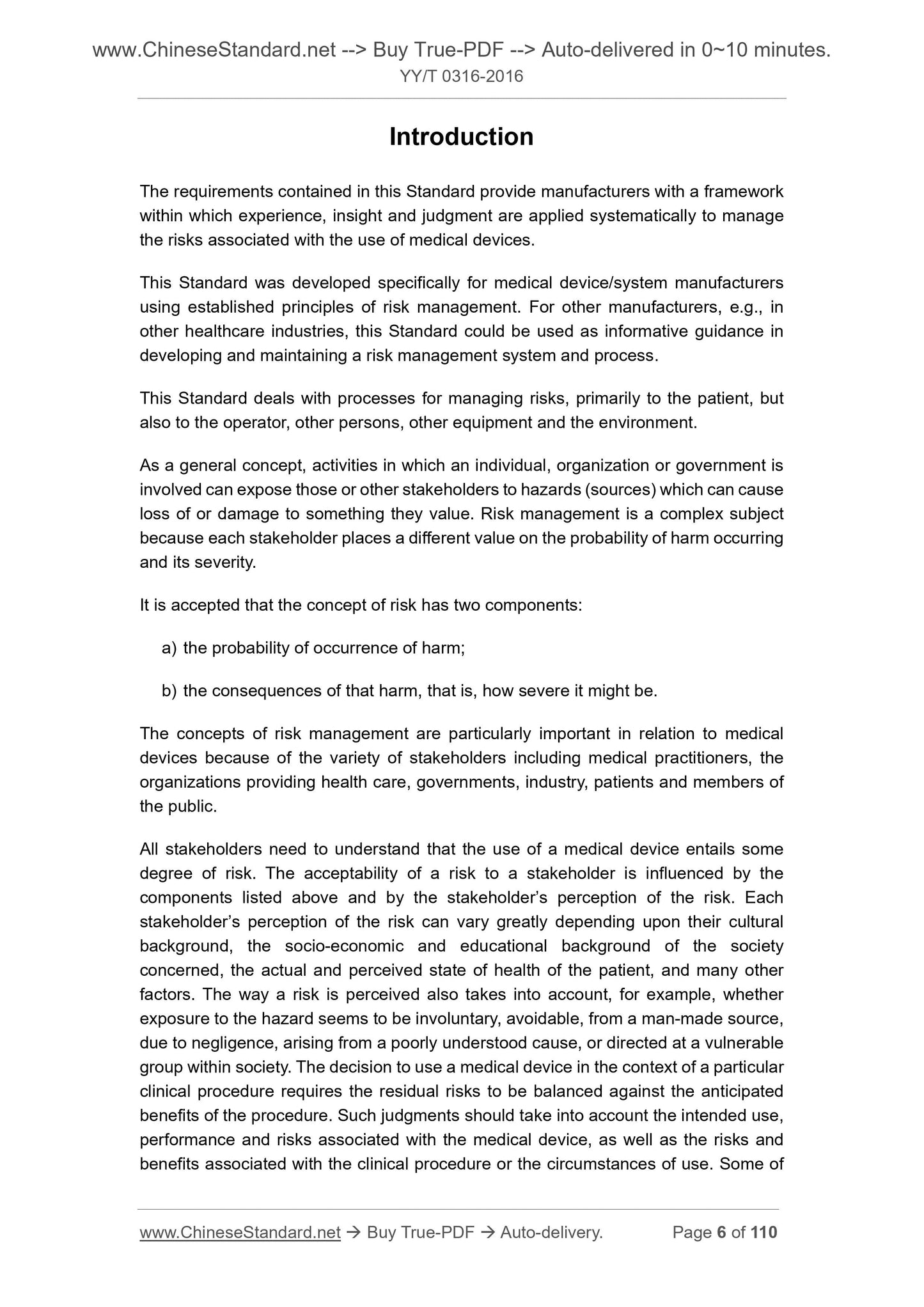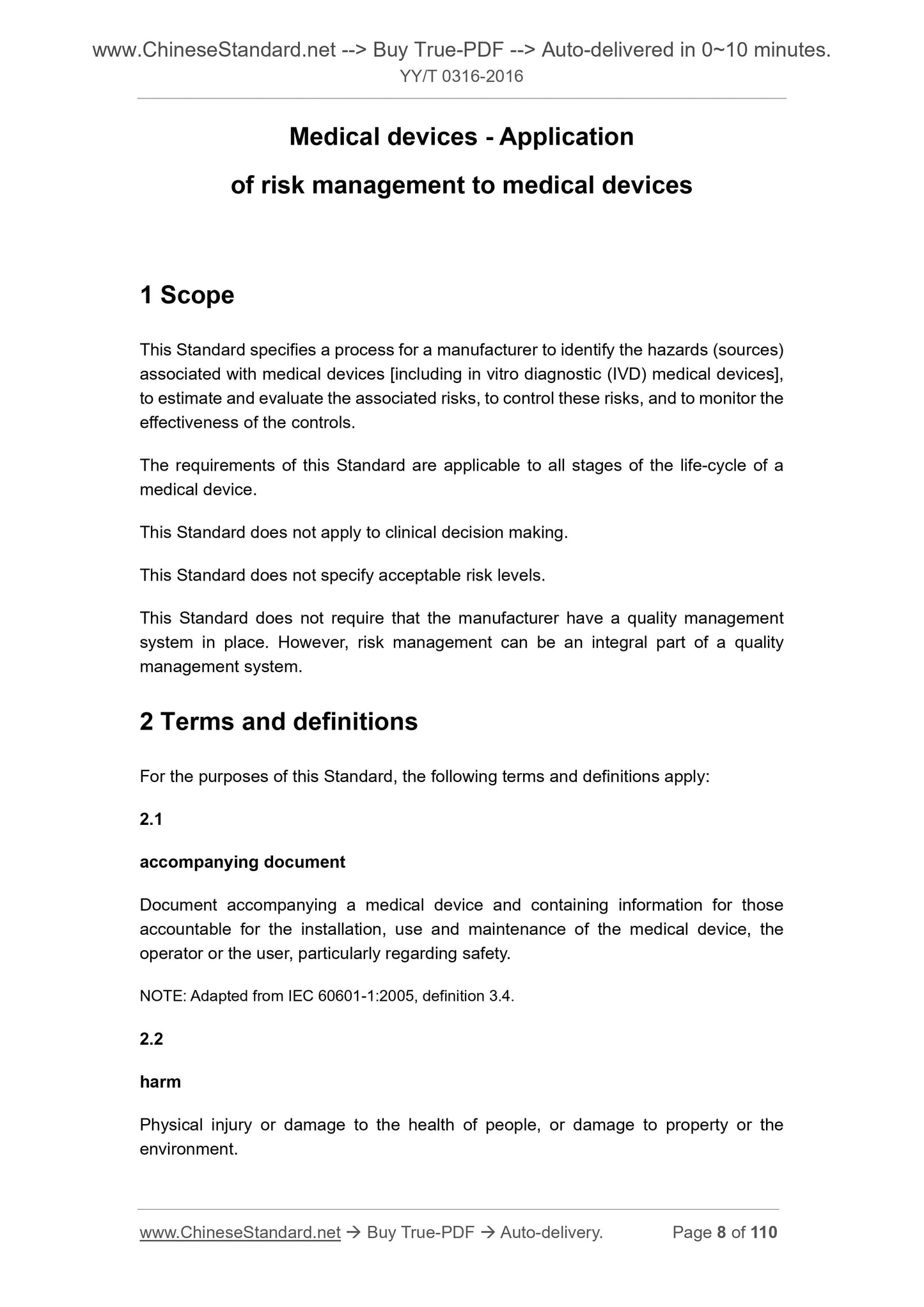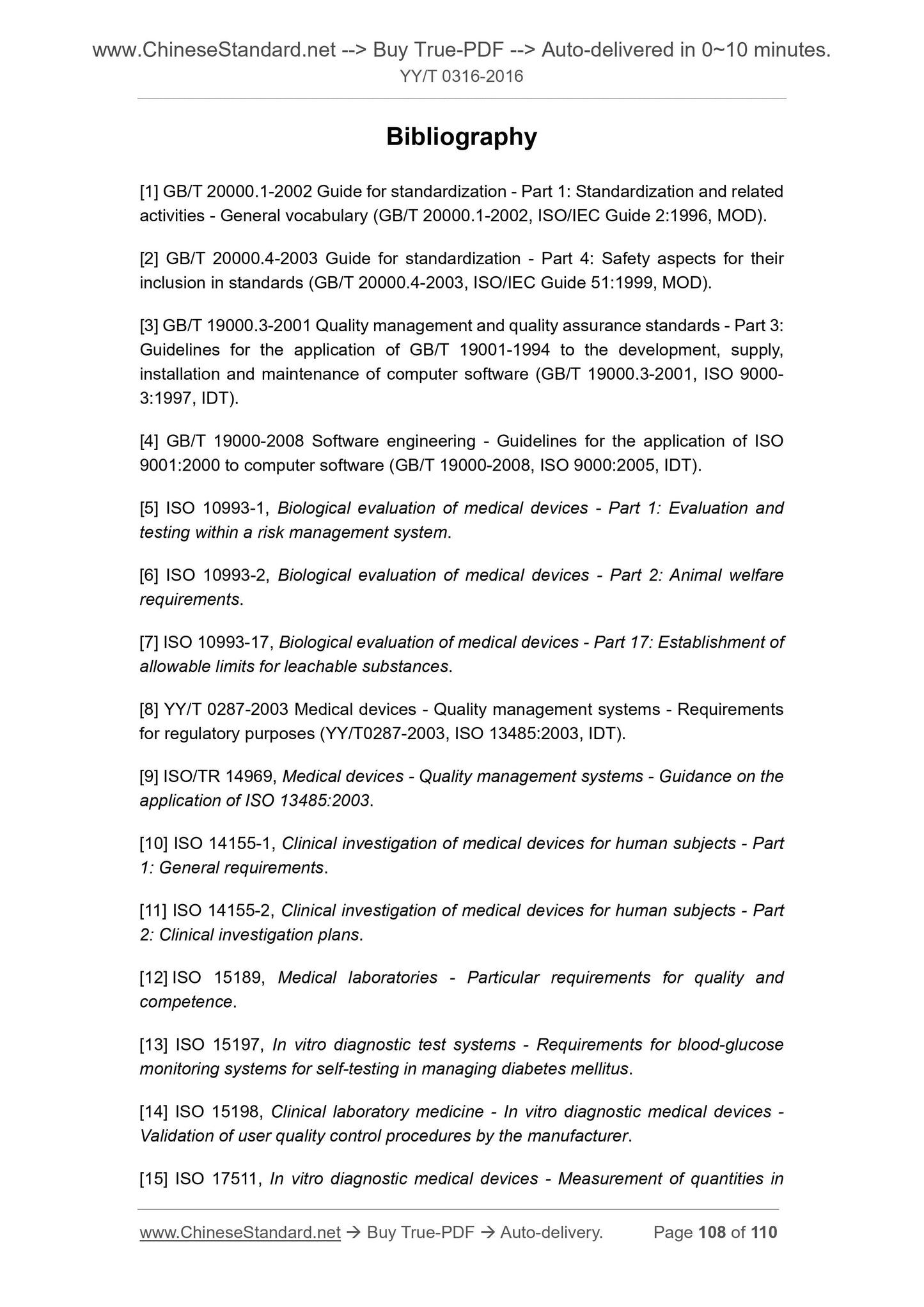1
/
su
7
PayPal, credit cards. Download editable-PDF and invoice in 1 second!
YY/T 0316-2016 English PDF (YYT0316-2016)
YY/T 0316-2016 English PDF (YYT0316-2016)
Prezzo di listino
$405.00 USD
Prezzo di listino
Prezzo scontato
$405.00 USD
Prezzo unitario
/
per
Spese di spedizione calcolate al check-out.
Impossibile caricare la disponibilità di ritiro
Delivery: 3 seconds. Download true-PDF + Invoice.
Get QUOTATION in 1-minute: Click YY/T 0316-2016
Historical versions: YY/T 0316-2016
Preview True-PDF (Reload/Scroll if blank)
YY/T 0316-2016: Medical devices - Application of risk management to medical devices
YY/T 0316-2016
Medical devices - Application of risk management to medical devices
ICS 11.040.01
C30
People's Republic of China pharmaceutical industry standards
Replacing YY/T 0316-2008
medical instruments
Application of Risk Management to Medical Devices
(ISO 14971.2007, revised edition, IDT)
2016-01-26 release
2017-01-01 implementation
State Food and Drug Administration released
Directory
Foreword Ⅲ
Introduction IV
1 range 1
2 Terms and definitions 1
3 General Requirements for Risk Management 4
3.1 Risk Management Process 4
3.2 Management responsibilities 6
3.3 Qualifications 6
3.4 Risk Management Plan 6
3.5 Risk Management Documents 7
4 Risk Analysis 7
4.1 Risk Analysis Process 7
4.2 Medical Devices Intended Use and Identification of Safety Related Features 7
4.3 Danger (source) identification 7
4.4 Estimating the Risks of Each Hazard 8
5 Risk Evaluation 8
6 Risk Control 8
6.1 reduce risk 8
6.2 Risk Control Program Analysis 8
6.3 The implementation of risk control measures 9
6.4 Residual risk assessment 9
6.5 Risk/Benefit Analysis 9
6.6 Risks arising from risk control measures 9
6.7 Integrity of risk control 10
7 Evaluation of the acceptability of the integrated residual risk 10
8 Risk Management Report 10
Post production and production information
Appendix A (informative) Description of the requirements of the principle 12
Appendix B (Informative) Medical Device Risk Management Process Overview 19
Appendix C (informative) Medical devices and safety-related features to identify the problem 21
Appendix D (informative) Concept of risk for medical devices 26
Appendix E (Informative) Examples of Hazardous (Source), Foreseeable Event Sequence and Hazard Situations 40
Appendix F (Informative) Risk Management Plan 45
Appendix G (informative) risk management technical information 47
Appendix H (informative) Guide to in vitro diagnostic medical device risk management 50
Appendix I (Informative) Biological Risk (Source) Risk Analysis Process Guide 63
Appendix J (informative) safety information and residual risk information 65
References 66
Foreword
This standard was drafted in accordance with the rules given in GB/T 1.1-2009.
This standard replaces YY/T 0316-2008 "medical device risk management of medical devices." And YY/T 0316-2008
In addition, editorial changes in addition to the main technical changes are as follows.
--- For and GB/T.20000.4-2003 "Standardization Guide Part 4. Standards related to the content of safety," the term
Consistently, the following eight terms and definitions have been revised.
--- "damage" revised as "injury" and revised the definition;
--- "Hazard" revised as "dangerous (source)", and revised the definition;
--- "Hazardous situation" revised as "dangerous situation" and revised definition;
--- Revised the definition of "residual risk";
--- Revised "risk" definition;
--- Revised "risk analysis" definition;
--- Revised the definition of "risk assessment";
--- "Safety" revised to "safety", and revised the definition.
--- According to ISO 14971.2007 (2007-10-01 more), amended the risk management process in Figure 1 Schematic.
This standard uses the translation method identical with ISO 14971.2007 "medical device risk management application of medical devices," a more correct version.
Please note that some of this document may be patentable. The issuing agencies of this document do not bear the responsibility of identifying these patents.
This standard proposed by the State Food and Drug Administration.
This standard by the National Medical Device Quality Management and General Requirements Standardization Technical Committee (SAC/TC221) centralized.
This standard was drafted by Beijing Guo Yi Huaguang Certification Co., Ltd.
The main drafters of this standard.Wang Huifang, Zheng a 菡, Milan British, Chen Zhigang.
This standard replaces the standards previously issued as.
--- YY/T 0316-2000, YY/T 0316-2003, YY/T 0316-2008.
introduction
This standard contains requirements for manufacturers to provide a systematic application of experience, knowledge and judgment management and the use of medical devices
Risk framework.
This standard was developed specifically for use by manufacturers of medical devices/systems that have established the principles of risk management. For other manufacturers, as in
In other health care industries, this standard can be used as an informative guide for establishing and maintaining risk management systems and processes.
This standard covers the risk management process, the main risk to the patient, but also includes the operator, other personnel, other equipment and the environment
risks of.
As a general concept, certain activities involving individuals, organizations or governments may expose these or those stakeholders to danger
Risk (source), or may cause loss or damage to the valuable items of the stakeholder. Because of each stakeholder, there is injury
The probability and severity of different values, risk management is a complex issue.
It is generally accepted that the concept of risk has two components.
a) the probability of injury occurring;
b) the consequences of the injury, ie, its severity.
Due to the diversity of stakeholders, including physicians, organizations providing health care, government, industry, patients and members of the public,
The concept of medical device risk management is particularly important.
All stakeholders must understand that the use of medical devices entails some degree of risk. Each stakeholder is at risk
The acceptability of the risk is influenced by the risk perception of the two components above and the stakeholders' risk perception. Risk per stakeholder
Being informed of the cultural background, socio-economic and educational background of the community concerned, the actual and perceived health status of the patient, and many other factors
The impact may vary greatly. The way of cognitive risk should also be taken into account, for example, whether it is unconscious about exposure to danger (source)
Avoidable, artificial, negligent, caused by little known reasons, or whether it is a vulnerable group in society. Use of medical equipment
The decision of the particular clinical procedure requires that the remaining risk be balanced against the expected benefits of the clinical procedure. Such judgments should be considered and medical treatment
The intended use, performance and risks associated with the device, and the risks and benefits associated with the clinical procedure or the environment in which it is used. Only understand the patient individual
Some of these judgments can be made by qualified physicians on the health status and patient's personal opinion.
As one of the stakeholders, manufacturers should take into account the generally accepted state of the art technology, the safety of medical devices, including
The acceptability of the risk is judged in order to determine the suitability of the medical device for its intended use. This standard specifies a process, according to
In this process, manufacturers of medical devices can identify hazards associated with medical devices (sources), evaluate and evaluate the winds associated with these hazards (sources)
Risk, control these risks and monitor the effectiveness of this control.
For any particular medical device, other international standards may require the application of a specific risk management method.
medical instruments
Application of Risk Management to Medical Devices
1 Scope
Get QUOTATION in 1-minute: Click YY/T 0316-2016
Historical versions: YY/T 0316-2016
Preview True-PDF (Reload/Scroll if blank)
YY/T 0316-2016: Medical devices - Application of risk management to medical devices
YY/T 0316-2016
Medical devices - Application of risk management to medical devices
ICS 11.040.01
C30
People's Republic of China pharmaceutical industry standards
Replacing YY/T 0316-2008
medical instruments
Application of Risk Management to Medical Devices
(ISO 14971.2007, revised edition, IDT)
2016-01-26 release
2017-01-01 implementation
State Food and Drug Administration released
Directory
Foreword Ⅲ
Introduction IV
1 range 1
2 Terms and definitions 1
3 General Requirements for Risk Management 4
3.1 Risk Management Process 4
3.2 Management responsibilities 6
3.3 Qualifications 6
3.4 Risk Management Plan 6
3.5 Risk Management Documents 7
4 Risk Analysis 7
4.1 Risk Analysis Process 7
4.2 Medical Devices Intended Use and Identification of Safety Related Features 7
4.3 Danger (source) identification 7
4.4 Estimating the Risks of Each Hazard 8
5 Risk Evaluation 8
6 Risk Control 8
6.1 reduce risk 8
6.2 Risk Control Program Analysis 8
6.3 The implementation of risk control measures 9
6.4 Residual risk assessment 9
6.5 Risk/Benefit Analysis 9
6.6 Risks arising from risk control measures 9
6.7 Integrity of risk control 10
7 Evaluation of the acceptability of the integrated residual risk 10
8 Risk Management Report 10
Post production and production information
Appendix A (informative) Description of the requirements of the principle 12
Appendix B (Informative) Medical Device Risk Management Process Overview 19
Appendix C (informative) Medical devices and safety-related features to identify the problem 21
Appendix D (informative) Concept of risk for medical devices 26
Appendix E (Informative) Examples of Hazardous (Source), Foreseeable Event Sequence and Hazard Situations 40
Appendix F (Informative) Risk Management Plan 45
Appendix G (informative) risk management technical information 47
Appendix H (informative) Guide to in vitro diagnostic medical device risk management 50
Appendix I (Informative) Biological Risk (Source) Risk Analysis Process Guide 63
Appendix J (informative) safety information and residual risk information 65
References 66
Foreword
This standard was drafted in accordance with the rules given in GB/T 1.1-2009.
This standard replaces YY/T 0316-2008 "medical device risk management of medical devices." And YY/T 0316-2008
In addition, editorial changes in addition to the main technical changes are as follows.
--- For and GB/T.20000.4-2003 "Standardization Guide Part 4. Standards related to the content of safety," the term
Consistently, the following eight terms and definitions have been revised.
--- "damage" revised as "injury" and revised the definition;
--- "Hazard" revised as "dangerous (source)", and revised the definition;
--- "Hazardous situation" revised as "dangerous situation" and revised definition;
--- Revised the definition of "residual risk";
--- Revised "risk" definition;
--- Revised "risk analysis" definition;
--- Revised the definition of "risk assessment";
--- "Safety" revised to "safety", and revised the definition.
--- According to ISO 14971.2007 (2007-10-01 more), amended the risk management process in Figure 1 Schematic.
This standard uses the translation method identical with ISO 14971.2007 "medical device risk management application of medical devices," a more correct version.
Please note that some of this document may be patentable. The issuing agencies of this document do not bear the responsibility of identifying these patents.
This standard proposed by the State Food and Drug Administration.
This standard by the National Medical Device Quality Management and General Requirements Standardization Technical Committee (SAC/TC221) centralized.
This standard was drafted by Beijing Guo Yi Huaguang Certification Co., Ltd.
The main drafters of this standard.Wang Huifang, Zheng a 菡, Milan British, Chen Zhigang.
This standard replaces the standards previously issued as.
--- YY/T 0316-2000, YY/T 0316-2003, YY/T 0316-2008.
introduction
This standard contains requirements for manufacturers to provide a systematic application of experience, knowledge and judgment management and the use of medical devices
Risk framework.
This standard was developed specifically for use by manufacturers of medical devices/systems that have established the principles of risk management. For other manufacturers, as in
In other health care industries, this standard can be used as an informative guide for establishing and maintaining risk management systems and processes.
This standard covers the risk management process, the main risk to the patient, but also includes the operator, other personnel, other equipment and the environment
risks of.
As a general concept, certain activities involving individuals, organizations or governments may expose these or those stakeholders to danger
Risk (source), or may cause loss or damage to the valuable items of the stakeholder. Because of each stakeholder, there is injury
The probability and severity of different values, risk management is a complex issue.
It is generally accepted that the concept of risk has two components.
a) the probability of injury occurring;
b) the consequences of the injury, ie, its severity.
Due to the diversity of stakeholders, including physicians, organizations providing health care, government, industry, patients and members of the public,
The concept of medical device risk management is particularly important.
All stakeholders must understand that the use of medical devices entails some degree of risk. Each stakeholder is at risk
The acceptability of the risk is influenced by the risk perception of the two components above and the stakeholders' risk perception. Risk per stakeholder
Being informed of the cultural background, socio-economic and educational background of the community concerned, the actual and perceived health status of the patient, and many other factors
The impact may vary greatly. The way of cognitive risk should also be taken into account, for example, whether it is unconscious about exposure to danger (source)
Avoidable, artificial, negligent, caused by little known reasons, or whether it is a vulnerable group in society. Use of medical equipment
The decision of the particular clinical procedure requires that the remaining risk be balanced against the expected benefits of the clinical procedure. Such judgments should be considered and medical treatment
The intended use, performance and risks associated with the device, and the risks and benefits associated with the clinical procedure or the environment in which it is used. Only understand the patient individual
Some of these judgments can be made by qualified physicians on the health status and patient's personal opinion.
As one of the stakeholders, manufacturers should take into account the generally accepted state of the art technology, the safety of medical devices, including
The acceptability of the risk is judged in order to determine the suitability of the medical device for its intended use. This standard specifies a process, according to
In this process, manufacturers of medical devices can identify hazards associated with medical devices (sources), evaluate and evaluate the winds associated with these hazards (sources)
Risk, control these risks and monitor the effectiveness of this control.
For any particular medical device, other international standards may require the application of a specific risk management method.
medical instruments
Application of Risk Management to Medical Devices
1 Scope
Share
